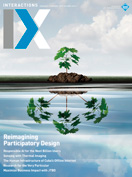Authors:
Gilbert Cockton, Simone Barbosa
Design is meant to make things better, and much HCI research and practice is aimed at making interaction design (IxD) better. What better means has greatly expanded as HCI has matured. Positions on what is better reflect values, which unite the content across this issue.
We should expect design excellence to be hard won in the face of irreducible complexity. Embracing complexity in IxD is core to a viable strategic vision where we must never stop learning. We must be flexible in embracing new values in HCI research and IxD practice, and avoid regressing to what is easiest and quickest. We must continue to nurture our discipline to empower it to flexibly manage incessant increases in the complexities that we must understand and embrace. Our long-term vision should be to deliver what is most worthwhile in the most practical way possible. HCI is becoming even more worthwhile by having even more ways to be worthwhile.
In her first Community Square column as SIGCHI president, Helena Mentis shares 10 values from the new SIGCHI Executive Committee (EC), many of which are in focus elsewhere in this issue. For example, in the cover story, Liam Bannon, Jeffrey Bardzell, and Susanne Bødker discuss three trends for participatory design (PD): 1) understanding democracy beyond workplaces in the context of massive global technology platforms, 2) inclusive use of novel creative design practices, and 3) continuous evolution of how we think about and practice PD—all reflected in this issue's cover image. These trends echo the EC values of being empowering, inclusive, collaborative, and bottom up. The first feature (Olav Bertelsen, Susanne Bødker, Eva Eriksson, Eve Hoggan, and Jo Vermeulen) argues for valuing the very particular at least as much as the general in HCI. In both articles, HCI is being asked to embrace new values in rapidly changing contexts.
In contrast, new values are advocated for in more stable HCI contexts, such as an outcomes focus in UX practice (Business of UX and Health Matters forums) and a usage focus in visualization guidelines (Blog@IX). At the same time, existing HCI values still matter in rapidly developing HCI contexts of technology usage: Equitable AI (fair and respectful in SIGCHI EC's values) must extend to the Global South (Next Billion forum). In the Sustainability in (Inter)Action forum, Tim Frick argues that sustainability can be demonstrably valued by design agencies of any size. In their report on a CHI 2018 workshop, Oussama Metatla, Anja Thieme, Emeline Brulé, Cynthia Bennett, Marcos Serrano, and Christophe Jouffrais argue that classroom UX must value inclusivity. Jonathan Bean's Consuming Tech column also considers inclusivity and equity in the context of new home and transport technologies.
Other articles address existing HCI values in new contexts of home and technology usage. EXIT pictures an owner's very basic value of keeping a mobile device dry when charging in the rain. Stuart Reeves, Martin Porcheron, and Joel Fischer show that home voice interfaces lack naturalness and seamlessness. Helena Tendedez, Kelly Widdicks, and Mike Hazas offer guidance on respect for ubicomp research participants in their homes. Elizabeth Churchill's Ps & Qs column continues a focus on bias and poor fit to human capabilities in AI recommendations. Turning to more recent technologies, thermal imaging (Interaction Technologies forum) offers many new opportunities, but Yomna Abdelrahman and Albrecht Schmidt have concerns over privacy.
Alongside these familiar HCI values of ubiquity, inclusivity, sustainability, innovation, specificity, fairness, privacy, protection, and respect for participants in research studies, Demo Hour and How Was It Made celebrate creative practice, and Alan Dix's Abracadabra and Michaelanne Dye's feature celebrate (and thus value) the local in South Wales and Cuba, respectively. Demo Hour also values nature as a material and inspiration for design. Last but not least, what Dan Lockton is reading offers more to perhaps value in dystopian fictions, storytelling, architecture, and the need to avert a new Dark Age.
Overall, many of the new EC's values for SIGCHI extend to HCI research and practice. Openness, especially in terms of setting realistic expectations for new technologies, is much valued in HCI. As worthwhile value propositions for IxD become more complex, it is more challenging to live up to the EC's values of being straightforward and efficient in our design work—we need to set realistic expectations for that too, until we become better masters of complexity.
Gilbert Cockton and Simone Barbosa [email protected]
Copyright held by authors
The Digital Library is published by the Association for Computing Machinery. Copyright © 2019 ACM, Inc.








Post Comment
No Comments Found